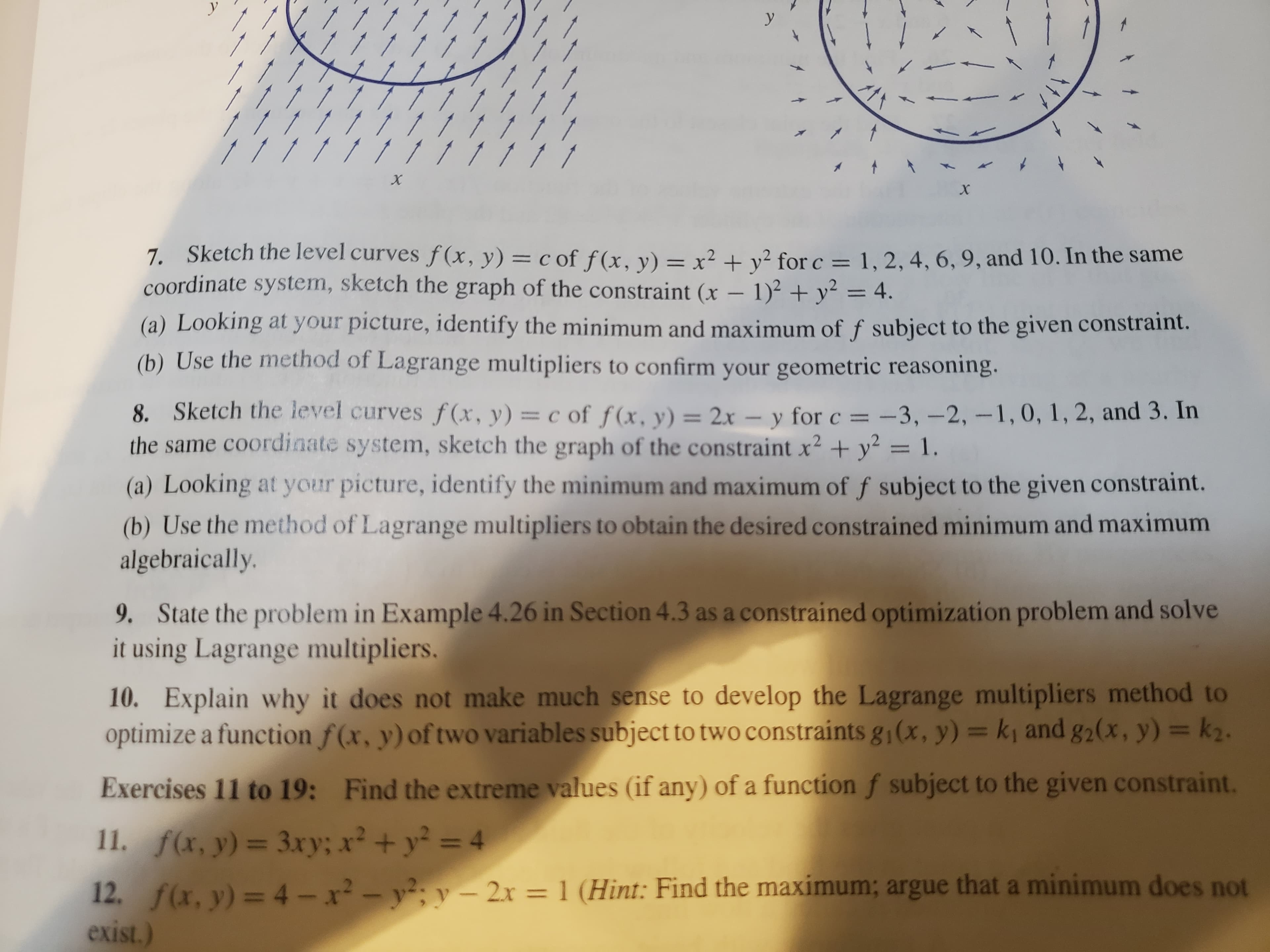7. Sketch the level curves f(x, y) = c of f (x, y) = x² + y² for c = 1, 2, 4, 6, 9, and 10. In the same coordinate system, sketch the graph of the constraint (x – 1)² + y² = 4. %3D (a) Looking at your picture, identify the minimum and maximum of f subject to the given constraint. (b) Use the method of Lagrange multipliers to confirm your geometric reasoning. 8. Sketch the level curves f(x, y) = c of f(x, y)= 2x – y for c = -3, –2, -1,0, 1, 2, and 3. In the same coordinate system, sketch the graph of the constraint x² + y² = 1. %3D %3D (a) Looking at your picture, identify the minimum and maximum of f subject to the given constraint. (b) Use the method of Lagrange multipliers to obtain the desired constrained minimum and maximum algebraically. 9. State the problem in Example 4.26 in Section 4.3 as a constrained optimization problem and solve it using Lagrange multipliers. 10. Explain why it does not make much sense to develop the Lagrange multipliers method to optimize a function f (x, y) of two variables subject to two constraints g1(x, y) = k, and g2(x, y) = k2. Exercises 11 to 19: Find the extreme values (if any) of a function f subject to the given constraint. 11. f(x, y)= 3xy; x² + y² = 4 12. f(x, y)=4-x- y; y – 2x = 1 (Hint: Find the maximum; argue that a minimum does not exist.) %3D
7. Sketch the level curves f(x, y) = c of f (x, y) = x² + y² for c = 1, 2, 4, 6, 9, and 10. In the same coordinate system, sketch the graph of the constraint (x – 1)² + y² = 4. %3D (a) Looking at your picture, identify the minimum and maximum of f subject to the given constraint. (b) Use the method of Lagrange multipliers to confirm your geometric reasoning. 8. Sketch the level curves f(x, y) = c of f(x, y)= 2x – y for c = -3, –2, -1,0, 1, 2, and 3. In the same coordinate system, sketch the graph of the constraint x² + y² = 1. %3D %3D (a) Looking at your picture, identify the minimum and maximum of f subject to the given constraint. (b) Use the method of Lagrange multipliers to obtain the desired constrained minimum and maximum algebraically. 9. State the problem in Example 4.26 in Section 4.3 as a constrained optimization problem and solve it using Lagrange multipliers. 10. Explain why it does not make much sense to develop the Lagrange multipliers method to optimize a function f (x, y) of two variables subject to two constraints g1(x, y) = k, and g2(x, y) = k2. Exercises 11 to 19: Find the extreme values (if any) of a function f subject to the given constraint. 11. f(x, y)= 3xy; x² + y² = 4 12. f(x, y)=4-x- y; y – 2x = 1 (Hint: Find the maximum; argue that a minimum does not exist.) %3D
Linear Algebra: A Modern Introduction
4th Edition
ISBN:9781285463247
Author:David Poole
Publisher:David Poole
Chapter2: Systems Of Linear Equations
Section2.4: Applications
Problem 17EQ
Related questions
Topic Video
Question
Can you help with 8 please?

Transcribed Image Text:7. Sketch the level curves f(x, y) = c of f (x, y) = x² + y² for c = 1, 2, 4, 6, 9, and 10. In the same
coordinate system, sketch the graph of the constraint (x – 1)² + y² = 4.
%3D
(a) Looking at your picture, identify the minimum and maximum of f subject to the given constraint.
(b) Use the method of Lagrange multipliers to confirm your geometric reasoning.
8. Sketch the level curves f(x, y) = c of f(x, y)= 2x – y for c = -3, –2, -1,0, 1, 2, and 3. In
the same coordinate system, sketch the graph of the constraint x² + y² = 1.
%3D
%3D
(a) Looking at your picture, identify the minimum and maximum of f subject to the given constraint.
(b) Use the method of Lagrange multipliers to obtain the desired constrained minimum and maximum
algebraically.
9. State the problem in Example 4.26 in Section 4.3 as a constrained optimization problem and solve
it using Lagrange multipliers.
10. Explain why it does not make much sense to develop the Lagrange multipliers method to
optimize a function f (x, y) of two variables subject to two constraints g1(x, y) = k, and g2(x, y) = k2.
Exercises 11 to 19: Find the extreme values (if any) of a function f subject to the given constraint.
11. f(x, y)= 3xy; x² + y² = 4
12. f(x, y)=4-x- y; y – 2x = 1 (Hint: Find the maximum; argue that a minimum does not
exist.)
%3D
Expert Solution
This question has been solved!
Explore an expertly crafted, step-by-step solution for a thorough understanding of key concepts.
This is a popular solution!
Trending now
This is a popular solution!
Step by step
Solved in 3 steps with 3 images

Knowledge Booster
Learn more about
Need a deep-dive on the concept behind this application? Look no further. Learn more about this topic, calculus and related others by exploring similar questions and additional content below.Recommended textbooks for you

Linear Algebra: A Modern Introduction
Algebra
ISBN:
9781285463247
Author:
David Poole
Publisher:
Cengage Learning


Algebra for College Students
Algebra
ISBN:
9781285195780
Author:
Jerome E. Kaufmann, Karen L. Schwitters
Publisher:
Cengage Learning

Linear Algebra: A Modern Introduction
Algebra
ISBN:
9781285463247
Author:
David Poole
Publisher:
Cengage Learning


Algebra for College Students
Algebra
ISBN:
9781285195780
Author:
Jerome E. Kaufmann, Karen L. Schwitters
Publisher:
Cengage Learning

Algebra: Structure And Method, Book 1
Algebra
ISBN:
9780395977224
Author:
Richard G. Brown, Mary P. Dolciani, Robert H. Sorgenfrey, William L. Cole
Publisher:
McDougal Littell